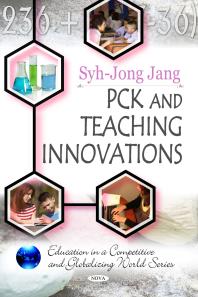(Ebook) PCK and Teaching Innovations by Syh-Jong Jang ISBN 9781614705666, 1614705666
Several series studies related to school science teachers’ PCK. Chapter one first describes the social constructive framework related to the research model. Then it addresses the related literature concerning PCK of pre-service and in-service science teachers, as well as the merits of models. Finally, a research-based model for PCK is presented. The process of PCK development involves the PCK-COPR module (Comprehension, Observation, Practice and Reflection).Then, chapter two demonstrated a group of pre-service teachers (n=23) to participate a technology-based PCK-COPR model designed to restructure science teacher education courses. There were significant differences in “pedagogical knowledge”, “technology knowledge” and “overall PCK” (F = 4.123, p < 0.05, F = 9.260, p < 0.01, and F= 6.372, p < 0.05, respectively.), but no significant differences in the other aspects. The innovative teaching experience could help pre-service teachers develop multiple teaching methods and strategies, and further enhanced their PCK. Chapter three was to examine the eighth-grade students’ perceptions of science teachers’ PCK difference between beginning teachers and experienced teachers, and the effects of applying the PCK-COPR model in the concepts of “electric circuits”. The research methods of students’ perceptions and teachers’ reflection could increase the learning and research experience of both in-service science teachers and the instructors and also serve as useful reference for other in-service teacher education institutes. Chapter four aimed to explore the impact of integrating a peer-coaching model into team teaching on PCK development of team teachers of secondary integrated science from a social constructivist approach. The research design included two-semester peer coaching and one-semester team teaching. Two simultaneous interventions should be conducive to science teachers’ creative thinking and collaborative relationship. Chapter five evaluated a three-stage collaborative concept-mapping technique in the fourth-grade science classes. The major issue investigated includes the student performance and responses toward the experimental teaching method. The findings showed that the two teaching methods reached significant difference with respect to students’ test scores. The experimental teaching method provided interaction, presentation and a way of progressing to enhance the learning outcome. Two studies demonstrated the innovative approaches of teaching and learning mathematics. Chapter six evaluated a collaborative learning model integrated into team teaching in the sixth-grade math classes. Three mathematics classes were assigned to Experimental Groups and Control Group for eight weeks in this study. The findings of the study showed the experimental teaching method enhanced students’ performance. Chapter seven was to evaluate a technology environment integrated into collaborative learning in sixth-graders' mathematics classes. The study focused the advantage of the constructivist view of teaching and learning process, which mainly highlighted three aspects including "active construction", "experiential learning" and "social interaction".
*Free conversion of into popular formats such as PDF, DOCX, DOC, AZW, EPUB, and MOBI after payment.


